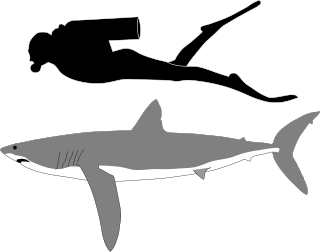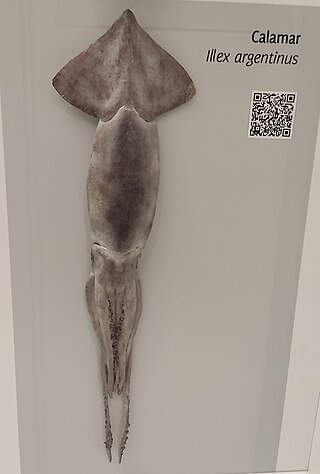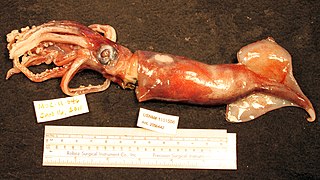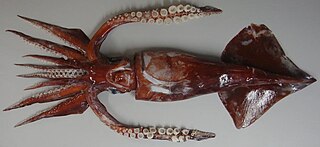
Ommastrephidae is a family of squid containing three subfamilies, 11 genera, and over 20 species. They are widely distributed globally and are extensively fished for food. One species, Todarodes pacificus, comprised around half of the world's cephalopod catch annually.

The Australian barracuda, arrow barracuda, Australian sea pike, sea pike, snook, or shortfin barracuda, Sphyraena novaehollandiae, is a barracuda of the genus Sphyraena which occurs in the south-western Pacific Ocean.

Maurolicus muelleri, commonly referred to as Mueller's pearlside,Mueller's bristle-mouth fish, or the silvery lightfish, is a marine hatchetfish in the genus Maurolicus, found in deep tropical, subtropical and temperate waters of the Pacific Ocean and the Atlantic Ocean, from the surface to depths of 1,500 metres (4,900 ft). It can grow to a maximum total length of 8 centimetres (3.1 in).

The European squid or common squid is a large squid belonging to the family Loliginidae. It occurs abundantly in coastal waters from the North Sea to at least the west coast of Africa. This species lives from sea level to depths of 500 m (1,600 ft). Its mantle is up to 40 cm (16 in) long. The species is extensively exploited by commercial fisheries.

The longfin mako shark is a species of mackerel shark in the family Lamnidae, with a probable worldwide distribution in temperate and tropical waters. An uncommon species, it is typically lumped together under the name "mako" with its better-known relative, the shortfin mako shark. The longfin mako is a pelagic species found in moderately deep water, having been reported to a depth of 220 m (720 ft). Growing to a maximum length of 4.3 m (14 ft), the slimmer build and long, broad pectoral fins of this shark suggest that it is a slower and less active swimmer than the shortfin mako.

Thysanoteuthis rhombus, also known as the diamond squid,diamondback squid, or rhomboid squid, is a large species of squid from the family Thysanoteuthidae which is found worldwide, throughout tropical and subtropical waters. T. rhombus is given its name for the appearance of the fins that run the length of the mantle. They are a fast growing species with a lifespan of approximately 1 year. The diamond squid is the only cephalopod species known to be monogamous. T. rhombus often preys on fish and other small cephalopods at varying water depths. This species is commercially fished in Japan, specifically in the Sea of Japan and Okinawa.

The Japanese flying squid, Japanese common squid or Pacific flying squid, scientific name Todarodes pacificus, is a squid of the family Ommastrephidae. This animal lives in the northern Pacific Ocean, in the area surrounding Japan, along the entire coast of China up to Russia, then spreading across the Bering Strait east towards the southern coast of Alaska and Canada. They tend to cluster around the central region of Vietnam.

Todaropsis eblanae, also known as the lesser flying squid, is a species of short finned squid in the monotypic genus Todaropsis of the family Ommastrephidae.

Illex argentinus, commonly known as the Argentine shortfin squid, is a species of squid in the family Ommastrephidae from the south western Atlantic Ocean.
The neon flying squid, sometimes called the red flying squid, akaika, and red squid is a species of large flying squid in the family Ommastrephidae. They are found in subtropical and temperate oceanic waters globally.

Illex, commonly known as shortfin squids, is a squid genus in the family Ommastrephidae and the only member of the subfamily Illicinae. It contains four species:

Illex coindetii, commonly known as the southern shortfin squid or broadtail shortfin squid, is a species of neritic squids in the family Ommastrephidae. They are found in the Mediterranean Sea and on both sides of the north Atlantic Ocean.

Illex oxygonius, commonly known as the sharptail shortfin squid, is a species of neritic squids in the family Ommastrephidae. Of the species of the genus Illex, they have the most restricted range, being found only in the western North Atlantic Ocean; from off New Jersey, south to the Straits of Florida and into the Gulf of Mexico. They are very difficult to distinguish from Illex coindetii and Illex illecebrosus, with which their geographic range overlaps. The most obvious difference of I. oxygnius is their sharper fin angles of 25° to 40°. There is also the possibility that they may be a hybrid of I. coindetii and I. illecebrosus.

The purpleback flying squid or purpleback squid is a species of cephalopod in the family Ommastrephidae, occurring in the Indo-Pacific. It is considered one of the most abundant large squids.

Alloteuthis media, the midsize squid or little squid, is a species of squid in the family Loliginidae from the eastern Atlantic and the Mediterranean Sea. It is generally a by-catch species in trawl fisheries, although there is an active fishery in the western Mediterranean.

Ornithoteuthis antillarum, the Atlantic bird squid, is a species of flying squid from the family Ommastrephidae which is found in the warmer waters of the Atlantic Ocean. This species is an important component of the diet of many species of fish and of cetaceans. It is taken as a bycatch in fisheries but has the potential to be commercially important if appropriate fishing methods can be developed.
The Angolan flying squid is a species of squid from the subfamily Todarodinae, part of the familyOmmastrephidae. Due to taxonomic confusion with the Antarctic flying squid the exact limits of its distribution are uncertain but it is thought to be restricted to waters off Southern Africa.

The Antarctic flying squid is a species of squid from the subfamily Todarodinae of the family Ommastrephidae, a family of pelagic squid from the order Oegopsida. It has a circumglobal distribution in the seas around the lower latitudes of the Southern Oceans.

The European flying squid is a species of squid from the continental slope and oceanic waters of the eastern Atlantic Ocean and the Mediterranean Sea. It is the type species of the genus Todarodes, the type genus of the subfamily Todarodinae of the pelagic squid family Ommastrephidae. It is a species which is targeted by some fisheries, although it is more often a bycatch.

Doryteuthis gahi, also known as the Patagonian longfin squid and Patagonian squid, is a small-sized squid belonging to the family Loliginidae. It occurs in coastal waters in the southeastern Pacific Ocean and the southwestern Atlantic Ocean where it is caught and eaten for food.




















